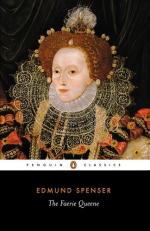468. FIRE-MOUTHED DRAGON. The dragons of romance are all described as fire-breathing,
473. THAT CHOSEN ART, a reference to the doctrine of Election. Mark, xiii, 20.
476. ACCURST HAND-WRITING. A reference to Paul’s letter to the Colossians, ii, 14, in which he declares that the gospel of grace has superseded the law of Moses.
484. HE SO HIMSELFE HAD DREST, he had thus attempted (to take his life).
QUESTIONS AND TOPICS
(Canto IX)
1. Give an account of Prince Arthur’s vision of the Faerie Queene. 2. Interpret his search for her as an allegory of the young man’s quest after his ideal. 3. Observe in xvii an allusion to Spenser’s patron, Lord Leicester, who was a favored suitor for Elizabeth’s hand. 4. What presents did the Knights exchange at parting? 5. Characterize Sir Trevisan by his appearance, speech, and actions. What does he symbolize? 6. Note the skill with which Spenser arouses interest before telling of the interview with Despair. 7. What was the fate of Sir Terwin? Its moral significance? 8. Describe the Cave of Despair, and show what effects are aimed at by the poet. 9. Compare with Despair Bunyan’s Giant Despair and the Man in the Iron Cage. 10. Trace the sophistries by which Despair works in the mind of the Knight, e.g. the arguments from necessity (fatalism), humanity, cowardice, discouragement and disgust on account of his past failures, dread of the future, of God’s justice, and the relief of death. 11. Does Despair show knowledge of the Knight’s past? 12. With what powerful truths does Una meet the arguments of Despair? 13. Where do you find reference to mediaeval art?
14. Find examples of Euphuism, metaphors, similes, Latinisms, and alliteration. 15. Explain the verb forms in ll. 154, 321, 336.
CANTO X
I. The Plot: The Redcross Knight is conducted by Una to the House of Holiness, where they are welcomed by Dame Coelia and graciously entertained. The Knight is instructed by Fidelia, Speranza, and Charissa, the three daughters of Coelia, in his relations to God and his fellow-men. He is healed in body, and undergoes discipline for his sins. Mercy conducts him through the Hospital of Good Works, where he sees her seven Beadsmen. He then with Una climbs the Hill of Contemplation and hears from a holy man the story of his past with a prophecy of his future, and obtains a view of the City of Heaven.
This must be pronounced the most beautiful canto of the first book.
II. The Allegory: 1. The Soul is brought by the Truth to a knowledge of the Heavenly Life (Coelia), and is led, through repentance, to seek forgiveness and to desire a holier life. Having learned Faith and Hope, it acquires a zeal for Good Works (Charity), and is strengthened by exercising Patience and Repentance. At last it enjoys a mood of happy Contemplation of the past with bright prospects for the future. The whole canto sets forth the beauty in a life of faith combined with good deeds.




